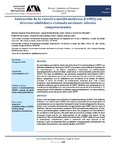| dc.contributor.author | Sánchez González, Sinaí del Rosario |
| dc.contributor.author | Segura Bailón, Brenda Anahí |
| dc.contributor.author | Serratos Álvarez, Iris Natzielly |
| dc.contributor.author | Millán Pacheco, César |
| dc.contributor.author | Vicente Escobar, Jonathan Osiris |
| dc.contributor.author | Galano Jiménez, Annia |
| dc.date.issued | 2019 |
| dc.identifier.citation | Sánchez-González, S.R., Segura-Bailón, B.A., Serratos-Álvarez, I.N., Millán-Pacheco, C., Vicente-Escobar, J.O. & Galano-Jiménez, A. (2019). Interacción de la catecol o-metiltransferasa (COMT) con diversos inhibidores evaluada mediante cálculos computacionales. Revista Tendencias en Docencia e Investigación en Química, 5(5), 635-640. http://hdl.handle.net/11191/7889 |
| dc.identifier.uri | http://hdl.handle.net/11191/7889 |
| dc.description.abstract | En este trabajo se estudió la interacción de la Catecol O-metiltransferasa (COMT) con diferentes inhibidores. Dado que la COMT es la enzima responsable de la degradación de catecolaminas y un blanco terapéutico importante en enfermedades neurodegenerativas. En este trabajo, exploramos el reconocimiento molecular entre COMT y dos tipos de inhibidores que presentan propiedades antioxidantes (IIcD y derivado de melatonina), por lo que sirven de protección ante el estrés oxidativo, y fueron comparados con los inhibidores por excelencia de la enzima. El análisis principal se centró en estudios de acoplamiento molecular para cada sistema propuesto y en la determinación de la energía libre de unión de las interacciones. Los resultados indicaron que la interacción de COMT-inhibidor está gobernada por las contribuciones hidrofóbicas, lo cual concuerda con lo reportado en la literatura. Y se comprobó que el IIcD, inhibidor modelado computacionalmente y con características antioxidantes, posee una mejor unión con la COMT. |
| dc.description.abstract | In this work the interaction of Catechol O-methyltransferase (COMT) with different inhibitors was studied. Since COMT is the enzyme responsible for the degradation of catecholamines and an important therapeutic target in neurodegenerative diseases. In this work, we explore the molecular recognition between COMT and two types of inhibitors that have antioxidant properties (IIcD and melatonin derivative), so they serve as protection against oxidative stress, and were compared with the inhibitors par excellence of the enzyme. The main analysis focused in docking studies for each proposed system and in the determination of the binding free energy of the interactions. The results indicated that the interaction of COMT-inhibitor is governed by hydrophobic contributions, which is consistent with that reported in the literature. And it was found that IIcD, an inhibitor computationally modeled and with antioxidant characteristics, has a better binding with COMT. |
| dc.format | pdf |
| dc.language.iso | spa |
| dc.publisher | Universidad Autónoma Metropolitana (México). Unidad Azcapotzalco. División de Ciencias Básicas e Ingeniería. |
| dc.relation.ispartof | https://revistatediq.azc.uam.mx/Docs/revista_tendencias_2019.pdf |
| dc.source | Revista Tendencias en Docencia e Investigación en Química. Año 5, número 5 (enero-diciembre de 2019). ISSN: 2448-6663 |
| dc.subject | Catecol O-metiltransferasa (COMT), energía de unión, interacciones hidrofóbicas. Catechól Omethyltransferase (COMT), binding energy, hydróphóbic interactións. |
| dc.subject.classification | BIOLOGÍA Y QUÍMICA::CIENCIAS DE LA VIDA::BIOQUÍMICA |
| dc.title | Interacción de la catecol o-metiltransferasa (COMT) con diversos inhibidores evaluada mediante cálculos computacionales |
| dc.type | Artículo |
| dc.format.digitalOrigin | Born digital |



